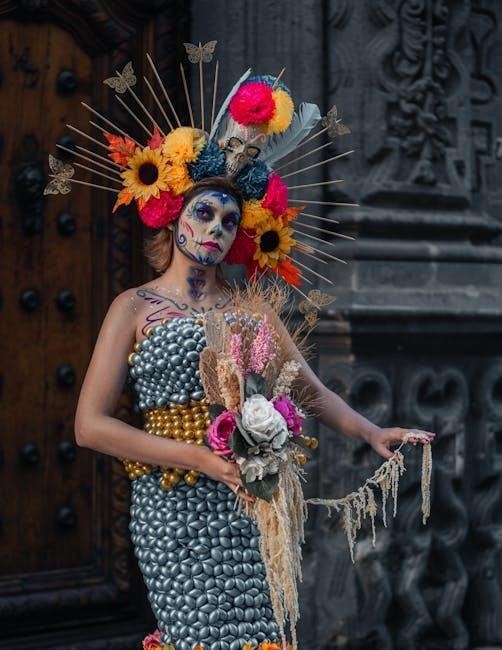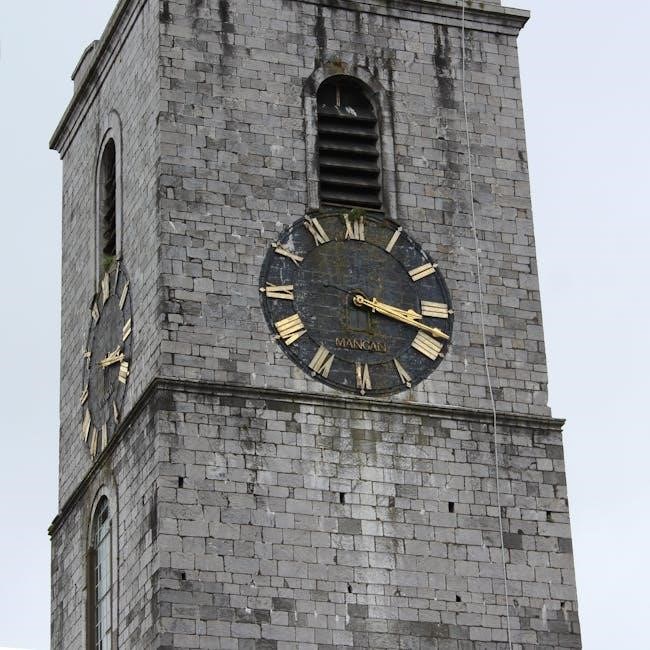1.1 Overview of “In the Time of the Butterflies”
The novel‚ set in the Dominican Republic‚ explores the lives of the Mirabal sisters‚ their resistance against Trujillo’s dictatorship‚ and their tragic fate‚ symbolized by the butterfly orchid.

In the Time of the Butterflies by Julia Alvarez is a poignant historical fiction novel that recounts the lives of the Mirabal sisters‚ who courageously opposed the oppressive regime of Rafael Trujillo in the Dominican Republic. The story intertwines their personal struggles‚ political activism‚ and ultimate sacrifice‚ set against the backdrop of a dictatorship. Through vivid storytelling‚ Alvarez explores themes of resistance‚ family‚ and resilience‚ while symbols like the butterfly orchid and rain serve as powerful motifs. The novel blends historical facts with fictional narrative‚ creating a compelling tribute to the Mirabal sisters’ legacy.
1.2 Historical Context
The novel is set in the Dominican Republic during the oppressive dictatorship of Rafael Trujillo‚ who ruled from 1930 to 1961. This period was marked by political repression‚ human rights violations‚ and a culture of fear. The Mirabal sisters’ resistance against Trujillo’s regime reflects the broader struggle for freedom and justice in the Caribbean nation. Alvarez’s portrayal of this era highlights the societal norms‚ political turmoil‚ and personal sacrifices that defined life under Trujillo’s rule‚ providing a historical backdrop for the sisters’ courageous actions.
1.3 Author Background: Julia Alvarez
Julia Alvarez‚ born in 1950 in New York to Dominican parents‚ grew up immersed in two cultures. Her family’s return to the Dominican Republic shaped her understanding of its history and culture. Alvarez’s writing often explores themes of identity‚ migration‚ and social justice. In the Time of the Butterflies reflects her deep connection to her heritage and her commitment to shedding light on the struggles of women under oppressive regimes‚ blending personal and historical narratives to create a powerful and enduring story.
Plot Summary
The novel recounts the Mirabal sisters’ courageous resistance against Trujillo’s dictatorship in the Dominican Republic‚ intertwined with symbolic elements like the butterfly orchid and rain‚ foreshadowing their tragic fate.
2.1 The Mirabal Sisters
The Mirabal sisters—Patria‚ Minerva‚ María Teresa‚ and Dedé—embody courage and resilience as they navigate life under Trujillo’s oppressive regime. Each sister’s unique personality shines through: Patria’s deep faith‚ Minerva’s fiery rebellion‚ María Teresa’s emotional depth‚ and Dedé’s quiet strength. Their shared commitment to justice and freedom unites them‚ even as personal struggles and tragic losses test their bond. The novel highlights their individual and collective journeys‚ weaving their stories into a tapestry of resistance‚ love‚ and sacrifice‚ ultimately cementing their legacy as symbols of hope and defiance.
2.2 The Dictatorship of Rafael Trujillo
Rafael Trujillo’s regime‚ spanning over three decades‚ was marked by ruthless suppression‚ fear‚ and control. His dictatorship dominated the Dominican Republic‚ stifling dissent and opposition through violence and surveillance. Trujillo’s rule created an atmosphere of terror‚ where even minor acts of defiance were met with brutal consequences. The Mirabal sisters’ resistance against his regime highlighted the oppressive nature of his governance‚ showcasing the human cost of living under such a tyrannical leader. Trujillo’s dictatorship serves as the backdrop for the novel‚ underscoring themes of oppression and the fight for freedom.
2.3 Key Events and Turning Points
Pivotal moments in the novel include the sisters’ early involvement in resistance‚ their arrests‚ and the eventual murder of Patria‚ Minerva‚ and María Teresa. Dedé’s survival and her role in preserving their legacy are central. The rain motif foreshadows tragedy‚ while the butterfly orchid symbolizes their fragile yet resilient spirit. These events highlight the sisters’ courage and the devastating impact of Trujillo’s regime‚ shaping the novel’s emotional and historical depth.

Main Characters
The Mirabal sisters—Patria‚ Minerva‚ María Teresa‚ and Dedé—each embody unique traits‚ from Patria’s faith to Minerva’s defiance. Their courage and sacrifice drive the story’s emotional core.

3.1 Patria Mirabal
Patria Mirabal‚ the eldest sister‚ is portrayed as deeply religious and maternal‚ often seeking solace in her faith. Her initial reluctance to join the resistance highlights her cautious nature‚ yet she eventually embraces the fight against Trujillo’s regime. Patria’s journey reflects her internal struggle between devotion to family and commitment to justice. Her story is marked by emotional depth‚ showcasing her transformation from a hesitant observer to a courageous participant in the sisters’ collective struggle‚ ultimately leading to her tragic fate.
3.2 Minerva Mirabal
Minerva Mirabal‚ the second sister‚ is depicted as fiercely independent and politically driven. Her defiance of Trujillo’s regime is evident from an early age‚ as she challenges authority and advocates for freedom. Minerva’s determination leads her to become a key figure in the resistance movement. Her story highlights her courage and unwavering commitment to justice‚ making her a symbol of strength and resilience. Despite her eventual imprisonment and tragic fate‚ Minerva’s spirit remains unbroken‚ inspiring others to fight against oppression.
3.3 María Teresa Mirabal
María Teresa‚ the youngest Mirabal sister‚ is portrayed as romantic and idealistic. Her diary entries reveal her deep emotions and personal growth. Initially naive‚ she evolves into a courageous activist‚ joining her sisters in the resistance. María Teresa’s journey from innocence to activism underscores her transformation and ultimate sacrifice. Her story adds a poignant layer to the novel‚ highlighting the personal costs of fighting for freedom and the enduring impact of her legacy.
3.4 Dedé Mirabal
Dedé Mirabal‚ the surviving sister‚ serves as the novel’s emotional anchor. Her narrative weaves the past and present‚ reflecting on her sisters’ courage and her own survival. Dedé’s life becomes a testament to their legacy‚ as she preserves their memory and shares their story. Her journey from guilt to acceptance highlights her resilience and the enduring bond with her sisters. Dedé’s character embodies the novel’s themes of loss‚ memory‚ and the power of storytelling to honor the past.
Themes
The novel explores themes of dictatorship‚ freedom‚ religion‚ and women’s courage‚ highlighting the Mirabal sisters’ resistance against oppression and their spiritual strength in the face of tragedy.
4.1 Dictatorship and Oppression
The novel vividly portrays the oppressive regime of Rafael Trujillo‚ highlighting the fear‚ control‚ and violence he imposed on the Dominican Republic. The Mirabal sisters’ defiance against his dictatorship underscores the human cost of authoritarian rule. Trujillo’s regime is depicted through its surveillance‚ imprisonment‚ and brutal suppression of dissent‚ creating a climate of terror. The sisters’ courage in resisting such oppression‚ despite the risks‚ becomes a powerful symbol of resistance against tyranny and the fight for freedom and justice in a society suffocated by dictatorship.
4.2 Freedom and Resistance
Freedom and resistance are central themes‚ as the Mirabal sisters embody the struggle against oppression. Their acts of defiance‚ from secret meetings to distributing anti-Trujillo pamphlets‚ illustrate the human spirit’s desire for liberation. Despite the risks‚ they resist the dictatorship‚ symbolizing hope and resilience. Their resistance not only challenges Trujillo’s regime but also inspires others to seek freedom‚ highlighting the power of collective action against tyranny and the enduring quest for justice and democracy in the face of overwhelming oppression.
4.3 Religion and Spirituality
Religion and spirituality play a significant role in shaping the Mirabal family’s identity and resilience. The novel highlights the interweaving of Catholicism with everyday life‚ as seen in the sisters’ prayers and the symbolic use of religious motifs. Spirituality serves as a source of comfort and strength‚ particularly during times of hardship. The butterfly orchid‚ a recurring symbol‚ reflects the connection between faith and transformation. Religion also influences moral decisions‚ guiding the sisters’ resistance against oppression while providing solace in the face of tragedy‚ blending personal devotion with the broader struggle for justice.
4.4 Women and Courage
The novel portrays the Mirabal sisters as embodiments of courage‚ challenging patriarchal norms and Trujillo’s oppressive regime. Their defiance‚ despite personal risks‚ highlights the strength of women in the face of tyranny. Through their actions‚ Alvarez underscores the transformative power of female resilience and the enduring impact of their sacrifices. The sisters’ courage is not just political but deeply personal‚ reflecting their commitment to justice and freedom‚ even in the face of overwhelming adversity‚ making them symbols of hope and inspiration for future generations.

Symbolism
The novel uses symbols like butterflies‚ representing freedom and transformation‚ and the butterfly orchid‚ signifying beauty and loss. Rain symbolizes tragedy and emotional turmoil‚ enriching the narrative depth.
5.1 The Butterflies as a Symbol
The butterflies symbolize freedom‚ transformation‚ and the sisters’ struggle against oppression. The Mirabal sisters‚ known as “Las Mariposas‚” embody resilience and hope. Their fight for justice and democracy mirrors the butterfly’s journey from confinement to flight. The novel uses this imagery to highlight their courage and the tragic sacrifice that becomes their legacy. The butterflies also represent the fleeting nature of life and the enduring impact of their resistance‚ inspiring future generations to seek freedom and stand against tyranny.
5.2 The Butterfly Orchid
The butterfly orchid serves as a poignant symbol in the novel‚ representing beauty‚ fragility‚ and the fleeting nature of life. Dedé’s prized orchid is a recurring motif‚ with its flowers often symbolizing the sisters’ delicate existence. When Dedé accidentally cuts off a flower‚ it foreshadows the tragic fate of the Mirabal sisters. The orchid’s presence throughout the story underscores themes of loss‚ memory‚ and the enduring impact of the sisters’ lives. Its beauty contrasts with the harsh realities of their world‚ making it a powerful and evocative symbol.
5.3 Rain as a Motif
Rain is a recurring motif in the novel‚ often signaling impending tragedy or emotional turmoil. It first appears during a family gathering‚ foreshadowing the sisters’ fate. Rain accompanies key events‚ such as the sisters’ arrests and their eventual deaths‚ creating a somber atmosphere. The motif also symbolizes cleansing and renewal‚ contrasting with the oppressive regime they resist. Through rain‚ Alvarez underscores the cyclical nature of life‚ loss‚ and memory‚ tying it to the Mirabal sisters’ enduring legacy and the emotional depth of their story.

Writing Style and Structure
Alvarez employs a non-linear narrative‚ blending historical fiction with vivid imagery. Multiple perspectives and flashbacks enrich the storytelling‚ while the structure mirrors the butterflies’ fragile yet resilient nature.
6.1 Narrative Techniques
Julia Alvarez uses a non-linear narrative‚ weaving multiple perspectives and flashbacks to create depth. The novel shifts between past and present‚ with Dedé’s voice anchoring the story. Alvarez employs vivid imagery and motifs‚ such as rain symbolizing tragedy‚ to enhance emotional resonance. The structure mirrors the butterflies’ fragile yet resilient nature‚ blending historical fiction with personal accounts. This technique allows readers to connect with the Mirabal sisters’ courage and tragedy‚ while the layered storytelling highlights the broader impact of their resistance against Trujillo’s regime.
6.2 Multiple Perspectives
The novel presents the story through the distinct voices of the four Mirabal sisters‚ offering a multifaceted view of their experiences. Each sister’s narrative provides unique insights into their personalities‚ struggles‚ and motivations. Patria’s religious devotion‚ Minerva’s political activism‚ María Teresa’s romantic idealism‚ and Dedé’s survival guilt are all explored. This approach creates a rich tapestry‚ allowing readers to understand the sisters’ individual and collective journeys. The shifting perspectives also highlight the broader societal impact of their resistance against Trujillo’s dictatorship‚ adding depth to the historical context.
6.3 Historical Fiction Elements
In the Time of the Butterflies blends historical facts with fictional narratives‚ creating a compelling portrayal of the Mirabal sisters’ lives under Trujillo’s dictatorship. Alvarez weaves real events‚ such as the sisters’ resistance and tragic fate‚ with imagined dialogues and personal struggles. The novel’s historical accuracy is balanced with creative storytelling‚ allowing readers to connect emotionally with the characters. This approach highlights the human cost of political oppression while maintaining the authenticity of the Dominican Republic’s tumultuous past. The fusion of history and fiction makes the story both educational and deeply engaging.

Reception and Reviews
In the Time of the Butterflies received widespread critical acclaim for its vivid portrayal of the Mirabal sisters and their courageous resistance. Readers praised its emotional depth and historical authenticity‚ while critics highlighted its masterful blend of fiction and fact. The novel has been recognized with numerous awards‚ solidifying its place as a powerful and poignant work of historical fiction.
7.1 Critical Acclaim
In the Time of the Butterflies has garnered widespread critical acclaim for its vivid portrayal of the Mirabal sisters’ courage and resilience. Reviewers praise Julia Alvarez’s masterful storytelling‚ blending historical facts with fictional narratives to create a compelling and emotional journey. The novel’s ability to capture the essence of oppression‚ resistance‚ and sisterhood has earned it a place among seminal works of historical fiction. Its recognition through awards and accolades underscores its impact on literature and its enduring relevance to readers worldwide.
7.2 Reader Responses
Readers have deeply connected with In the Time of the Butterflies‚ praising its emotional depth and historical significance. Many find inspiration in the Mirabal sisters’ courage and resilience‚ resonating with their struggle for freedom. The novel’s vivid storytelling and relatable characters have made it a favorite among book clubs and individual readers alike. Its ability to blend history with fiction has sparked widespread admiration‚ particularly for its portrayal of women’s roles in resistance movements. The book’s impact continues to grow‚ fostering meaningful discussions about courage‚ family‚ and societal change.
7.3 Awards and Recognition
In the Time of the Butterflies has received widespread critical acclaim and numerous awards. Julia Alvarez was honored with the American Book Award for her powerful portrayal of the Mirabal sisters’ courage. The novel has also been recognized for its historical significance and literary merit‚ earning a place on lists such as the “100 Best Novels of the 20th Century.” Its impact has been further celebrated through adaptations and educational curricula‚ solidifying its legacy as a timeless work of historical fiction.
The PDF Version
The PDF version of In the Time of the Butterflies offers a convenient digital format‚ featuring study guides‚ summaries‚ and analysis for easy access and reading.
8.1 Features of the PDF
The PDF version of In the Time of the Butterflies includes a detailed summary‚ character analysis‚ and exploration of themes. It features significant quotes‚ a biography of Julia Alvarez‚ and a breakdown of key events. The digital format enhances accessibility‚ allowing readers to highlight and annotate sections. Additionally‚ it provides historical context and a study guide for deeper understanding. This comprehensive resource is ideal for students and readers seeking a thorough analysis of the novel.
8.2 Benefits of the Digital Format
The digital format of In the Time of the Butterflies offers enhanced accessibility and convenience. Readers can easily navigate through sections‚ highlight important passages‚ and annotate for study purposes. The PDF is shareable across devices‚ making it ideal for group discussions or classroom use. Its compact size saves physical storage space while maintaining clarity. This format also supports environmental sustainability by reducing the need for printed copies‚ appealing to eco-conscious readers seeking a modern way to engage with the novel.
8.3 Accessibility and Sharing
The PDF format enhances accessibility‚ allowing readers to zoom in on text for better readability and use screen readers for visually impaired individuals. Sharing the document is seamless‚ as it can be easily emailed or uploaded to cloud platforms. This convenience fosters collaboration‚ enabling group discussions and classroom activities. The ability to share the PDF widely ensures that the story of the Mirabal sisters reaches a broader audience‚ promoting education and awareness about their courage and legacy.

Study Guide and Analysis
This section provides a detailed breakdown of the novel‚ including chapter summaries‚ character insights‚ and thematic explorations‚ offering a comprehensive understanding of the story and its elements.
9.1 Chapter Summaries
The chapter summaries provide a concise overview of each section‚ highlighting key events and character developments. Early chapters introduce the Mirabal sisters and their family dynamics‚ setting the tone for their eventual resistance. Dedé’s narrative voice weaves through the story‚ offering insights into her survival and the loss of her sisters. The summaries emphasize symbolic moments‚ such as the butterfly orchid and rain motifs‚ which foreshadow tragedy. These summaries also explore Dedé’s life after her sisters’ deaths‚ including her ironic career in life insurance‚ underscoring the novel’s themes of loss and resilience.
9.2 Character Analysis
Dedé Mirabal emerges as the central figure‚ grappling with the loss of her sisters and the weight of their legacy. Her narrative voice reveals a complex mix of grief‚ guilt‚ and resilience. The summaries highlight her internal struggles‚ such as her feelings about her sisters’ martyrdom and her own survival. Dedé’s character evolves as she navigates a life defined by tragedy‚ yet she finds purpose in preserving their memory. Her ironic career in life insurance underscores the novel’s themes of loss and the enduring impact of her sisters’ courage.
9.3 Theme Exploration
The novel delves into themes of dictatorship‚ freedom‚ and tragedy‚ highlighting the Mirabal sisters’ resistance against Trujillo’s regime. The butterfly orchid symbolizes their delicate yet resilient struggle‚ while rain foreshadows impending tragedy. Themes of religion and spirituality are intertwined with their fight for justice‚ offering solace amidst oppression. The sisters’ courage and sacrifice underscore the cost of resistance‚ while Dedé’s survival serves as a testament to their enduring legacy. These themes are explored through vivid imagery and poignant narrative‚ creating a powerful exploration of human resilience and sacrifice.
9.4 Significant Quotes
Patria reflects‚ “I saved myself for God‚ but He wanted me to serve the people instead.” This highlights her spiritual struggle and commitment to justice. Minerva declares‚ “If they kill me‚ I’ll rise in the arms of my people‚ a butterfly.” This embodies her defiance and hope for freedom. María Teresa writes in her diary‚ “I want to scream‚ but the scream stays inside me.
Dedé remarks‚ “I survived‚ but my sisters were the brave ones.” These quotes capture the essence of sacrifice‚ resilience‚ and the enduring spirit of the Mirabal sisters.
Essay Topics and Discussion Questions
- How do the Mirabal sisters embody courage and resistance in the face of oppression?
- Discuss the role of religion in shaping the characters’ motivations and actions.
- Analyze the symbolism of the butterfly orchid and its significance to the story.
- Examine the impact of Trujillo’s dictatorship on the Mirabal family and society.
- What lessons can be drawn from the sisters’ sacrifices and legacy?
10.1 Analyzing the Mirabal Sisters
The Mirabal sisters—Patria‚ Minerva‚ María Teresa‚ and Dedé—each embody unique strengths and vulnerabilities. Their diverse personalities and roles in the resistance against Trujillo’s dictatorship highlight their courage and resilience. Minerva’s fiery determination contrasts with Patria’s religious devotion‚ while María Teresa’s romantic idealism and Dedé’s survival instincts complete the portrait of a family united in sacrifice. Their deaths serve as a tragic reminder of the cost of rebellion‚ yet their legacy endures as symbols of freedom and women’s empowerment‚ inspiring future generations to stand against oppression.

10.2 The Role of Religion
Religion plays a significant role in shaping the Mirabal sisters’ identities and motivations. Patria’s deep Catholic faith influences her moral compass and decision-making‚ while the family’s religious practices provide solace amid turmoil. The novel highlights how religion intersects with political resistance‚ offering a moral framework for their actions. Trujillo’s regime often clashed with religious values‚ further fueling the sisters’ defiance. Through their faith‚ the Mirabals find strength and purpose‚ illustrating how spirituality can both comfort and inspire resistance in the face of oppression.
10.3 Symbolism in the Novel
The novel is rich in symbolism‚ with the butterfly orchid and rain serving as poignant motifs. The butterfly orchid symbolizes the sisters’ delicate beauty and tragic fate‚ while rain foreshadows impending tragedy. The butterflies themselves represent freedom‚ resistance‚ and transformation‚ embodying the sisters’ struggle against oppression. These symbols weave together to create a powerful narrative that underscores themes of hope‚ loss‚ and resilience. Alvarez’s use of symbolism adds depth and emotional resonance to the story‚ making it a compelling exploration of courage and sacrifice.
“In the Time of the Butterflies” leaves a lasting impact‚ celebrating the Mirabal sisters’ courage and legacy while highlighting themes of resistance and sacrifice.

11.1 Final Thoughts
“In the Time of the Butterflies” is a poignant tale of courage‚ sacrifice‚ and resilience. The Mirabal sisters’ fight against oppression inspires hope and reflects the power of unity. Dedé’s survival underscores the enduring legacy of her sisters‚ whose memory lives on as symbols of resistance. The novel’s blend of history and fiction creates a compelling narrative‚ reminding readers of the importance of standing against tyranny. Alvarez’s work remains a powerful tribute to the sisters and their unwavering spirit.
11.2 Impact of the Novel
“In the Time of the Butterflies” has left a lasting impact on readers worldwide. Its vivid portrayal of the Mirabal sisters’ courage and sacrifice has raised awareness about the Dominican Republic’s turbulent history under Trujillo; The novel’s emotional depth and historical significance have made it a beloved and educational resource‚ particularly in its PDF format‚ which is widely used in classrooms and by book clubs. Alvarez’s storytelling has not only honored the sisters’ memory but also inspired discussions on freedom‚ oppression‚ and the strength of the human spirit.
11.3 Legacy of the Mirabal Sisters
The Mirabal sisters’ courage and sacrifice have left an enduring legacy‚ inspiring future generations to fight for freedom and justice. Their story‚ immortalized in “In the Time of the Butterflies‚” has become a symbol of resistance against oppression. The novel’s PDF version ensures their memory lives on‚ educating readers about their bravery and the tragic events of the Dominican Republic’s past. The sisters’ legacy continues to empower women and highlight the importance of standing against dictatorship‚ making their story a timeless testament to human resilience and the fight for liberty.
